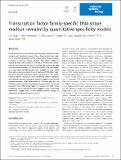| dc.contributor.author | Yang, Lin | |
| dc.contributor.author | Orenstein, Yaron | |
| dc.contributor.author | Jolma, Arttu | |
| dc.contributor.author | Yin, Yimeng | |
| dc.contributor.author | Taipale, Jussi | |
| dc.contributor.author | Shamir, Ron | |
| dc.contributor.author | Rohs, Remo | |
| dc.date.accessioned | 2018-05-09T15:48:50Z | |
| dc.date.available | 2018-05-09T15:48:50Z | |
| dc.date.issued | 2017-02 | |
| dc.date.submitted | 2017-01 | |
| dc.identifier.issn | 1744-4292 | |
| dc.identifier.uri | http://hdl.handle.net/1721.1/115256 | |
| dc.description.abstract | Transcription factors (TFs) achieve DNA-binding specificity through contacts with functional groups of bases (base readout) and readout of structural properties of the double helix (shape readout). Currently, it remains unclear whether DNA shape readout is utilized by only a few selected TF families, or whether this mechanism is used extensively by most TF families. We resequenced data from previously published HT-SELEX experiments, the most extensive mammalian TF–DNA binding data available to date. Using these data, we demonstrated the contributions of DNA shape readout across diverse TF families and its importance in core motif-flanking regions. Statistical machine-learning models combined with feature-selection techniques helped to reveal the nucleotide position-dependent DNA shape readout in TF-binding sites and the TF family-specific position dependence. Based on these results, we proposed novel DNA shape logos to visualize the DNA shape preferences of TFs. Overall, this work suggests a way of obtaining mechanistic insights into TF–DNA binding without relying on experimentally solved all-atom structures. | en_US |
| dc.publisher | Nature Publishing Group | en_US |
| dc.relation.isversionof | http://dx.doi.org/10.15252/msb.20167238 | en_US |
| dc.rights | Creative Commons Attribution 4.0 International License | en_US |
| dc.rights.uri | http://creativecommons.org/licenses/by/4.0/ | en_US |
| dc.source | EMBRO Press | en_US |
| dc.title | Transcription factor family‐specific DNA shape readout revealed by quantitative specificity models | en_US |
| dc.type | Article | en_US |
| dc.identifier.citation | Yang, Lin et al. “Transcription Factor Family‐specific DNA Shape Readout Revealed by Quantitative Specificity Models.” Molecular Systems Biology 13, 2 (February 2017): 910 © 2017 The Authors | en_US |
| dc.contributor.department | Massachusetts Institute of Technology. Computer Science and Artificial Intelligence Laboratory | en_US |
| dc.contributor.mitauthor | Orenstein, Yaron | |
| dc.relation.journal | Molecular Systems Biology | en_US |
| dc.eprint.version | Final published version | en_US |
| dc.type.uri | http://purl.org/eprint/type/JournalArticle | en_US |
| eprint.status | http://purl.org/eprint/status/PeerReviewed | en_US |
| dc.date.updated | 2018-05-09T14:38:16Z | |
| dspace.orderedauthors | Yang, Lin; Orenstein, Yaron; Jolma, Arttu; Yin, Yimeng; Taipale, Jussi; Shamir, Ron; Rohs, Remo | en_US |
| dspace.embargo.terms | N | en_US |
| dc.identifier.orcid | https://orcid.org/0000-0002-3583-3112 | |
| mit.license | PUBLISHER_CC | en_US |
